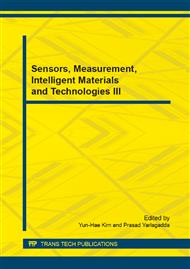[1]
Yu-Jin Hong, Ig-Jae Kim, Sang Chul Ahn, Hyoung-Gon Kim, Activity Recognition using Wearable Sensors for Elder Care, IEEE journal on Future Generation Communication and Networking, vol. 2, 2008, pp.302-305.
DOI: 10.1109/fgcn.2008.165
Google Scholar
[2]
Uslu G., Altun O., Baydere S., A Bayesian approach for indoor human activity monitoring, IEEE International Conference on Hybrid Intelligent Systems (HIS), 2011, pp.324-327.
DOI: 10.1109/his.2011.6122126
Google Scholar
[3]
Sharma, A. ; Young-Dong Lee ; Wan-Young Chung, High Accuracy Human Activity Monitoring Using Neural Network, Convergence and Hybrid Information Technology, vol. 1, 2008, pp.430-435.
DOI: 10.1109/iccit.2008.394
Google Scholar
[4]
Xi Long ; Bin Yin ; Aarts, R.M., Single-accelerometer-based daily physical activity classification, Engineering in Medicine and Biology Society, EMBC 2009. Annual International Conference of the IEEE, 2009, pp.6107-7110.
DOI: 10.1109/iembs.2009.5334925
Google Scholar
[5]
Chernbumroong, S. ; Atkins, A.S. ; Hongnian Yu, Activity classification using a single wrist-worn accelerometer, IEEE International Conference on Software, Knowledge Information, Industrial Management and Applications (SKIMA), 2011, pp.1-6.
DOI: 10.1109/skima.2011.6089975
Google Scholar
[6]
Roggen, D. ; Calatroni, A. ; Rossi, M. ; Holleczek, T. ; Forster, K. ; Troster, G. ; Lukowicz, P. ; Bannach, D. ; Pirkl, G. ; Ferscha, A. ; Doppler, J. ; Holzmann, C. ; Kurz, M. ; Holl, G. ; Chavarriaga, R. ; Sagha, H. ; Bayati, H. ; Creatura, M. ; del R Millan, J., Collecting complex activity datasets in highly rich networked sensor environments, Seventh International Conference on Networked Sensing Systems (INSS), 2010, pp.233-240.
DOI: 10.1109/inss.2010.5573462
Google Scholar
[7]
Lukowicz, P. ; Pirkl, G. ; Bannach, D. ; Wagner, F. ; Calatroni, A. ; Foerster, K. ; Holleczek, T. ; Rossi, M. ; Roggen, D.; Troester, G. ; Doppler, J. ; Holzmann, C. ; Riener, A. ; Ferscha, A. ; Chavarriaga, R., Recording a Complex, Multi Modal Activity Data Set for Context Recognition, 23rd International Conference on Architecture of Computing Systems (ARCS), 2010, pp.1-6.
DOI: 10.1109/wowmom.2009.5282442
Google Scholar
[8]
Jolliffe, I.T., Principal Component Analysis, second edition (Springer), 2002, p.487.
Google Scholar


